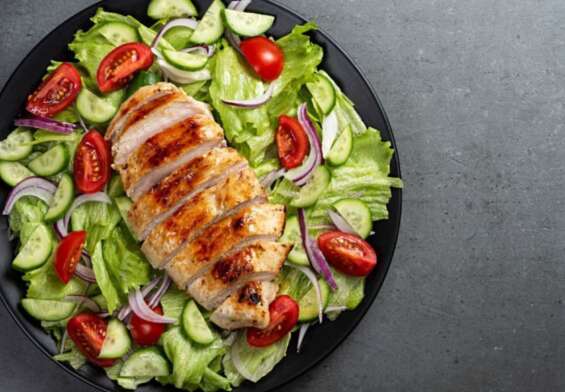
The Flexitarian Diet: Eat Healthier Without Giving Up Meat
The Flexitarian Diet is a flexible approach to eating that focuses on eating mostly plant-based foods while allowing for moderate amounts of meat and other animal products. It is a great way to enjoy the health and environmental benefits of a vegetarian diet without sacrificing the occasional treat. This diet encourages you to make plant-based foods the primary part of your diet while allowing for the occasional indulgence in animal products. By following this diet, you can improve your health, reduce your environmental impact, and still enjoy the foods you love.
What is a Flexitarian Diet and How Can it Benefit Your Health?
Are you always in the mood to eat something delicious, but you’re not sure what? Well, let us introduce you to a diet that may just be perfect for you: the flexitarian diet! Flexitarians are people who follow a flexible vegetarian diet. They don’t cut out all animal products, but instead focus on mostly plant-based foods, occasionally adding in small amounts of animal proteins.
The flexitarian diet isn’t just about eating healthy; it’s also about having a lot of fun with your food! You can still enjoy delicious dishes while also reaping the health benefits of a vegetarian diet. Plus, since you’re not strictly limiting yourself, you won’t get bored with your meals.
The flexitarian diet can benefit your health in many ways. Eating a mostly plant-based diet can help reduce the risk of heart disease and diabetes, as well as help lower cholesterol levels. It can also help you maintain a healthy weight and reduce inflammation.
So, if you’re looking for a diet that allows you to eat a variety of delicious foods while still reaping the health benefits of a vegetarian diet, the flexitarian diet may be just what you’re looking for! So don’t be afraid to flex your culinary muscles and have a flexitarian feast today!
Tips for Making the Transition to a Flexitarian Diet
- Start Small: Take baby steps when transitioning to a flexitarian diet! Start by adding more plant-based meals to your diets, such as salads and vegetable-based soups.
- Get Creative: You don’t have to give up your favorite dishes to become a flexitarian. Get creative and experiment with plant-based versions of your favorite recipes.
- Don’t Go Cold Turkey: You don’t have to completely give up meat to become a flexitarian. Start by swapping out a few meals a week that contain meat for plant-based alternatives.
- Get Inspired: There are tons of inspiring flexitarian recipes online, so take advantage and try something new.
- Experiment with Meat Alternatives: There are plenty of meat alternatives available in stores these days, such as tofu and tempeh. Experiment with these products to see what you like best!
- Stock Up on Healthy Snacks: Being a flexitarian doesn’t mean you have to give up snacks. Stock up on healthy and delicious snacks, such as nuts and seeds, to keep you full between meals.
- Don’t Be Too Hard on Yourself: Making a lifestyle change can be tough, so don’t be too hard on yourself if you slip up or don’t stick to it perfectly. Just keep trying and you’ll get there!
Plant-Based Foods to Include in a Flexitarian Diet
Flexitarians, rejoice! Here are some delicious plant-based foods you can add to your flexitarian diet:
Tofu: Move over, chicken! Tofu is a great source of plant-based protein, and it can be prepared in so many delicious ways. Try grilling it up with a yummy marinade, or you can fry it up like a breakfast scramble. It’s a totally awesome choice!
Veggie Burgers: Ditch the beef and try veggie burgers instead. These tasty patties are filled with all sorts of delicious ingredients, from mushrooms to black beans to quinoa. Enjoy them on a bun with your favorite toppings for a truly meat-free meal.
Nuts and Seeds: Nuts and seeds are a great addition to your flexitarian diet. They’re a great source of healthy fats and protein, and they come in so many varieties. Try adding walnuts to your salads, or sprinkle some chia seeds in your smoothie for an extra boost of nutrition.
Beans and Legumes: Beans and legumes are an excellent source of plant-based protein, and they’re incredibly versatile. Try adding some lentils to your soups and stews, or use black beans to make some delicious vegan tacos.
Veggies: No flexitarian diet is complete without plenty of veggies. Whether you’re roasting them, stir-frying them, or adding them to your salads, veggies are a great way to get in all your essential nutrients.
These are just a few of the delicious plant-based foods you can add to your flexitarian diet. So go ahead, flex your flexitarian muscles and get creative with your cooking!
How to Get Enough Protein on a Flexitarian Diet
If you’re a flexitarian – someone who is mostly vegetarian, but occasionally eats meat – you may be wondering how to get enough protein in your diet. Well, don’t worry – it’s easier than you think! Here are some humorous tips to get enough protein in your flexitarian diet:
- Get “flexitarian” protein bars: You know those protein bars that are meant for athletes? Well, now there are “flexitarian” protein bars that have all the protein you need, without any animal products. They’re delicious and they’ll give you the energy boost you need.
- Have a “flexitarian” smoothie: If you’ve got a blender, you’ve got a meal. Throw some vegan protein powder, fruit, and veggies into the blender and you’ve got a nutritious, protein-packed meal.
- Eat more beans: Beans are a great source of protein for flexitarians. Try making a big batch of chili or a burrito bowl with black beans, and you’ll have a protein-packed meal that’s sure to keep you full.
- Go nuts: Nuts and nut butter are great sources of protein, and they’re easy to add to any meal. A handful of almonds makes a great snack, and adding a spoonful of peanut butter to your oatmeal will give you a protein boost.
- Add some tofu: Tofu is a great source of protein, and it’s incredibly versatile. You can add it to stir fry, soup, or even make it into a sandwich.
So, there you have it – five easy ways to make sure you get enough protein in your flexitarian diet. With these tips, you’ll be sure to stay full and energized all day long!
Pros and Cons of a Flexitarian Diet
Pros
- You get to eat all the yummy things — Being a flexitarian means you can enjoy all the delicious foods you love, just with some modifications. No need to give up your favorite dishes!
- You can still indulge your cravings — A flexitarian diet gives you the flexibility to indulge in whatever you’re craving, whether it’s a steak or a veggie burger.
- You don’t have to sacrifice flavor — Flexitarianism isn’t about sacrificing flavor. Instead, you can still enjoy your favorite flavors with healthier alternatives.
- It’s easier on your wallet — Since a flexitarian diet allows you to purchase cheaper meat alternatives, you’ll save money in the long run.
Cons
- It takes some getting used to — If you’re used to eating a certain way, it may take some time to adjust to a flexitarian lifestyle.
- You may feel deprived — A flexitarian diet can be restrictive at times, which can make it difficult to stick with.
- It’s hard to get enough protein — Getting enough protein can be challenging on a flexitarian diet, so it’s important to make sure you’re getting enough from other sources.
- It can be difficult to find meals — Finding meals that are both flexitarian and delicious can be a challenge.
Creative Ways to Incorporate a Flexitarian Diet into Your Lifestyle
- Make it a flex-it-arian diet: find a way to make it work for you. If you’re not ready to completely commit, try “Flexit”—a combination of flexitarian and vegetarian. For example, you can eat vegan meals one day and then have a meat-based meal the next.
- Get creative in the kitchen. Think of your flexitarian diet as a challenge to get creative with plant-based ingredients. You can whip up delicious plant-based meals without ever getting bored.
- Start small. Don’t try to change your diet all at once. Start out by gradually replacing animal products in certain dishes with plant-based alternatives. For example, if you’re accustomed to eating burgers, try making a veggie burger or a bean-based burger.
- Find flexitarian-friendly restaurants. Many restaurants now offer flexitarian-friendly dishes on their menus. Look for restaurants that specialize in vegetarian and vegan cuisine or ask your favorite restaurant to make some flexitarian-friendly substitutions.
- Get your friends and family on board. Invite your friends and family over for a flexitarian dinner party. Not only will it be a great way to share your new lifestyle with those you care about, but it’ll also give you a chance to get creative in the kitchen.
- Make it fun. Flexitarianism is all about finding a way to make it work for you. Make it fun by trying out new recipes and experimenting with different ingredients. There’s no wrong way to do it.
The Flexitarian Diet and Weight Loss: What You Need to Know
Are you looking to lose weight but don’t want to commit to a full-on vegetarian or vegan lifestyle? Then the flexitarian diet may be just the thing you need! Flexitarians, otherwise known as “semi-vegetarians,” follow a mostly vegetarian diet but still eat small amounts of animal products on occasion.
So, can a flexitarian diet really help you lose weight? Absolutely! The flexitarian diet is a great way to reduce your calorie intake without feeling deprived and missing out on the foods you love. Plus, it helps you get the nutrition you need from plant-based sources, like whole grains, legumes, nuts, fruits, and vegetables.
The flexitarian diet has many benefits that can help you lose weight, including:
- Eating Less Processed Foods: This type of diet encourages you to eat more whole, unprocessed foods. This means more nutrient-dense options that fill you up, like whole grains and fresh produce, which can help reduce your overall calorie intake.
- Reduced Animal Product Intake: Animal products are often high in calories, saturated fat, and sodium, which can all lead to weight gain when consumed in excess. By limiting your intake of animal products, you can reduce your calorie consumption and help you reach your weight loss goals.
- Increased Fiber Intake: Eating more plant-based foods on the flexitarian diet can help you get the fiber you need. Fiber helps you feel fuller for longer, so you’re less likely to snack in between meals. It can also help regulate your blood sugar levels, which can help keep cravings at bay.
So, if you’re looking to lose weight without giving up the foods you love, then the flexitarian diet is a great option for you. With its focus on whole, unprocessed foods and reduced animal product intake, you can enjoy a healthy lifestyle and reach your weight loss goals in no time!
Easy Flexitarian Recipes for Busy Weeknights
- Taco Salad Bowl: Start with a bed of greens, pile on some black beans, and top it off with some fresh diced tomatoes and avocados. Then, get creative with your protein: choose from grilled chicken, sautéed mushrooms, or even some store-bought veggie crumbles. Finish it off with a squeeze of lime, a dollop of salsa, and a sprinkle of cheese, and you’ve got yourself a flexitarian feast!
- Peanut Butter Noodle Bowl: All you need for this one is a package of pre-cooked ramen noodles, a spoonful of peanut butter, and some veggies of your choice. Sauté the veggies until they’re tender, toss in the noodles and the peanut butter, and you’ve got yourself a delicious and effortless meal that’s sure to make you the envy of all your other flexitarian friends.
- Quesadilla Pizza: Who says you can’t have pizza on a flexitarian diet? Certainly not us! For this one, start with a pre-made whole-wheat tortilla, spread on some tomato sauce, add some diced veggies of your choice, and top it off with a sprinkle of cheese. Pop it in the oven and you’ve got yourself a delicious and easy quesadilla pizza that’s sure to satisfy your flexitarian cravings.
- Veggie-Loaded Stir Fry: This one’s a no-brainer. Start with some pre-cut veggies of your choice and let them sizzle in a pan with some oil. Add a splash of soy sauce and a sprinkle of your favorite spices, and you’re good to go! Serve it with some cooked grains of your choice and you’ve got yourself a tasty and easy meal that’s sure to please.
- Lentil Sloppy Joes: Start with some cooked lentils, stir in some tomato sauce and your favorite seasonings, and top it off with some shredded cheese. Serve it up on a whole-wheat bun and you’ve got yourself a delicious and hearty flexitarian meal that’s sure to have you begging for seconds.
How to Find Flexitarian-Friendly Restaurants Where You Live
Are you a flexitarian and looking for a restaurant to enjoy a delicious meal? Look no further, because we’ve got all the tips you need to find flexitarian-friendly restaurants near you!
First, head to Google and see what restaurants come up when you type in “flexitarian restaurants near me.” You’ll probably find some options right away, but if you don’t, don’t worry! There are still plenty of ways to find flexitarian-friendly restaurants.
One great way to find flexitarian-friendly restaurants is to ask around. Ask your friends and family if they know of any places that offer good flexitarian options. They may have some great recommendations for you!
Another great way to find flexitarian-friendly restaurants is to search online. There are numerous websites and forums devoted to flexitarianism and many of them will have recommendations for restaurants in your area.
Finally, you can use social media to your advantage. Look for local restaurant pages and accounts and see if they offer flexitarian options. You can also search for hashtags like #flexitarian or #flexitarianfriendly to see what comes up.
So, there you have it. With a bit of searching, you should have no problem finding some delicious flexitarian-friendly restaurants near you. Bon appetit!
Crafting Healthy, Balanced Flexitarian Meals
Are you ready to flex your culinary muscles? Flexitarianism is all about enjoying a mostly plant-based diet, with occasional animal-based protein thrown in for good measure. Here are a few tips for crafting tasty, healthy, balanced flexitarian meals.
First, think about the main dish. If you’re having a meat-based protein, aim for lean cuts like chicken or turkey. If you’re going the vegetarian route, consider something like a veggie-packed stir fry, black bean burritos, or a bean-based chili.
Next, create a balanced plate by adding some veggies. Whether you’re having a plant- or animal-based protein, make sure to include at least one type of veggie in your meal. Roasted broccoli or asparagus, sautéed spinach, or a simple salad are all great choices.
Now it’s time for some whole grains! Brown rice, quinoa, and bulgur wheat are all excellent options for flexitarian meals.
Finally, don’t forget about some healthy fats. A sprinkle of nuts, a drizzle of olive oil, or a dollop of avocado are all great ways to add some good-for-you fats to your meal.
See? Flexitarian meals don’t have to be complicated. With a little bit of creativity and the right ingredients, you can make delicious and nutritious meals that are sure to satisfy your taste buds and your waistline. Bon appétit!
The Benefits of a Flexitarian Diet for Vegetarians and Meat Eaters Alike
Are you a vegetarian who’s still craving a juicy burger? Or are you a meat-eating friend who wants to cut down on the animal products in your diet? If you’ve answered yes to either of these questions, then a flexitarian diet might be your answer!
A flexitarian diet is a flexible approach to eating that allows both vegetarians and meat-eaters alike to get the best of both worlds. It’s all about finding the balance between consuming mostly plant-based foods, while still allowing for the occasional animal product. It’s not an all-or-nothing approach; it’s about making mindful choices and learning to enjoy a variety of foods.
The obvious benefit of a flexitarian diet is that it can help you reduce your intake of animal products while still getting enough protein. It also allows you to enjoy the occasional treat without having to feel guilty about it. Plus, it allows you to explore different types of cuisine and flavors without completely overhauling your diet.
But the best part of a flexitarian diet is that it can be tailored to your individual needs. Whether you want to cut down on animal products for ethical reasons or just want to make healthier choices, a flexitarian diet can be tailored to your specific needs.
So if you’re looking for a way to enjoy the best of both worlds, look no further than a flexitarian diet. It’s an easy and enjoyable way to give your diet a makeover!
Conclusion
In conclusion, the Flexitarian Diet is a great way to get started on a healthier lifestyle. It encourages people to incorporate more plant-based foods into their diets while still allowing for some animal-based foods. It is also a great way to reduce your environmental impact, as the majority of the diet consists of plant-based foods that require fewer resources to produce. With the Flexitarian Diet, you can eat more healthily and still enjoy the occasional treat.











